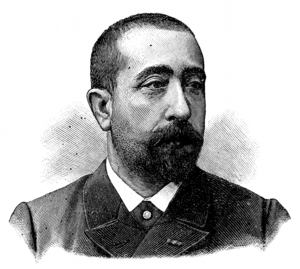Georges Gilles de la Tourette
| Georges Gilles de la Tourette | |
|---|---|
 | |
| Born |
30 October 1857 Saint-Gervais-les-Trois-Clochers, Vienne, France |
| Died |
26 May 1904 (aged 46) Lausanne, Switzerland |
| Known for | Tourette syndrome |
| Signature | |
 | |
Georges Albert Édouard Brutus Gilles de la Tourette (30 October 1857 – 26 May 1904) was a French physician and the namesake of Tourette's syndrome, a neurological condition characterized by physical and verbal tics.[1] He was born in the small town of Saint-Gervais-les-Trois-Clochers in the district of Châtellerault, near the city of Loudun.[2] He could be retrospectively classified as a neurologist, but the field did not exist in his time.
During 1873 Tourette began medical studies at Poitiers. He later relocated to Paris where he became a student, amanuensis, and house physician of his mentor, the influential contemporary neurologist Jean-Martin Charcot, director of the Salpêtrière Hospital. Charcot also helped him to advance in his academic career. Tourette studied and lectured in psychotherapy, hysteria and medical and legal ramifications of mesmerism (modern-day hypnosis).[1]
Tourette described the symptoms of Tourette's syndrome in nine patients in 1884, using the name "maladie des tics". Charcot renamed the syndrome "Gilles de la Tourette's illness" in his honor.[1]
In 1893, a former female patient shot Tourette in the head, claiming he had hypnotized her against her will. Both Tourette and many modern hypnologists state that this is impossible. His mentor, Charcot, had died recently, and his young son had also died recently. After these events, Tourette began to experience mood swings between depression and hypomania. Nevertheless, he organized public lectures in which he spoke about literacy, mesmerism and theatre.[1]
Tourette published an article on hysteria in the German Army, which angered Bismarck, and a further article about unhygienic conditions in the floating hospitals on the river Thames. With Gabriel Legué he analyzed abbess Jeanne des Anges' account of her hysteria that was allegedly based on her unrequited love for a priest Urbain Grandier, who was later burned for witchcraft.[1]
Around 1902, Tourette's condition worsened and he was dismissed from his post. Gilles de la Tourette died on 26 May 1904 in a psychiatric hospital in Lausanne, Switzerland.[1]
Writings

- L'hypnotisme et les états analogues au point de vue médico-légal (Paris, 1887; 2nd. edition Paris 1889)
- Traité clinique et thérapeutique de l'hystérie d'après l'enseignement de la Salpêtrière (Paris 1891)
- Les actualités médicales, les états neurasthéniques (Paris 1898)
- Leçons de clinique thérapeutique sur les maladies du système nerveux (Paris 1898)
- Les actualités médicales. Formes cliniques et traitement des myélites syphilitiques' convulsifs (La semaine médicale 1899)
References
- 1 2 3 4 5 6 Enersen, Ole Daniel and a reputed magnetizer. Georges Albert Édouard Brutus Gilles de la Tourette. Archived 9 March 2005 at the Wayback Machine. WhoNamedIt.com Retrieved on 14 May 2007.
- ↑ Teive HA, Chien HF, Munhoz RP, Barbosa ER (December 2008). "Charcot's contribution to the study of Tourette's syndrome". Arq Neuropsiquiatr. 66 (4): 918–21. doi:10.1590/S0004-282X2008000600035. PMID 19099145.
Sources
- Black, KJ. Tourette Syndrome and Other Tic Disorders. eMedicine (22 March 2006). Retrieved on 27 June 2006.
- Bogousslavsky J, Walusinski O. Gilles de la Tourette's criminal women: the many faces of fin de siècle hypnotism. Clin Neurol Neurosurg. 2010 Sep;112(7):549-51.
- Georges Gilles de la Tourette: The Man And His Times. PubMed.gov. Retrieved on 10 July 2012.
- Lees. A.J. Georges Gilles de la Tourette: The Man And His Times (Paris 1986)
- Louchart A. French scientists: Aristocratic names get short shrift. Nature 2013 Feb 14;494(176). Retrieved on 15 February 2013.
- Walusinski O, Bogousslavsky J. Georges Gilles de la Tourette (1857–1904). J Neurol. 2011 Jan;258(1):166-7
- Walusinski O, Duncan G. Living his writings: the example of neurologist G. Gilles de la Tourette. Mov Disord. 2010 Oct 30;25(14):2290-5.
Further reading
- Rickards H, Cavanna AE. Gilles de la Tourette: the man behind the syndrome. J Psychosom Res. 2009;67(6):469–74. doi:10.1016/j.jpsychores.2009.07.019. PMID 19913650.
External links
